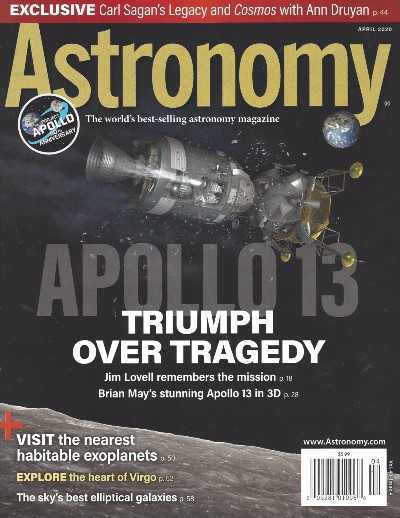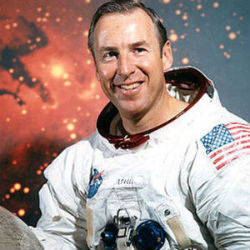April 1970: ‘Look to the Skies…’
By Neil Earle

The motto “look to the skies” is a mantra among the scientifically curious, the UFO community and a band of science fantasists from H.G. Wells to Ray Bradbury.
Fifty years ago in April, 1970 for dwellers on Planet Earth this was hard to avoid.
Apollo 13 blasted off from Cape Kennedy on the 11th and began climbing towards its goal, the third landing on the lunar surface, specifically a highland area named Fra Mauro, a 50 mile crater noted for unusual geological features that would enhance the “sceince” aspect of this latest mission. The first moon landing had entranced the world in July, 1969 but now a new environmentalism was taking hold concerned with things here on earth and many felt future missions needed a more scientific and practical rationale.
As Lovell, Haise and Swigert streaked towards the silvery sphere, the mission was greeted with an almost ho-hum reaction down on earth. None of the major networks had covered their televised transmission halfway through the flight.
How quickly things were to change.
“We have a problem!”
About three quarters of the way to the moon the three Astronauts suddenly heard a loud bang. They were to learn later that an overheated oxygen tank had exploded and damaged the other one. Lovell looked back at a flume of gaseous substance as oxygen poured from the stricken craft. “We knew quite quickly that we were in a dying vehicle.” The men immediately made plans to move from the “Odyssey” spacecraft to the lunar module (LM) that was scheduled to land and explore the moon’s surface. Three men crammed into a space designed for two with a dwindling supply of electricity and water, one of them soon suffering from a viral infection.
“Houston, we’ve had a problem” was radioed back to Mission Control on earth. Gene Krantz marshaled his crew in Houston with the declaration that “our darkest hour will be our finest hour.”
All of a sudden three men trapped in a fragile lifeboat 200,000 miles from home became an international sensation. “News reports became ever more fanatic,” remembers writer David Eicher. NASA worried about the build-up of carbon dioxide inside the cramped module that could kill the men. This sped the most crucial and yet humble scientific feat of the whole enterprise: the creation of a lithium hydroxide cansiter to purify the air of excess carbon dioxide in the LM. The savior was a jury-rigged contraption they called the mailbox. The genius was allowing pieces from the command module – with the help of cardboard, grey tape and a sock (!) – to fit like a square box onto the cylindrical outlets in the LM. “It was a miraculous thing,” Lovell later remembered.
 Jim Lovell
Jim LovellJury-rigged it was but it worked. Now they had to negotiate the tricky maneuver of reentry which was always a critical stage for the whole lunar program, difficult at the best of times even with a healthy spacecraft. As they hit the earth’s atmosphere the radio blackout between the reentry procedure which meant losing communications with Mission Control took six minutes, longer than normal. But a joyful voice soon penetrated the earphones of Frantz and his team: “Okay, Joe!” Swigert radioed to Houston. The Navy was waiting to pick them from the India Ocean and the three men retuned to a tumultuous reception on planet earth.
Lovell’s Sermon
Apollo 13 had been Jim Lovell’s fourth NASA mission and it meant he had to scratch his goal of landing on the moon. Like so many of the astronauts, such awe-inspiring views of earth, moon and stars lingered with him. “There’s an old saying, ‘I hope to go to heaven when I die,’” Lovell recalled years later. “Suddeny it dawned on me that we went to heaven when we were born! We arrived on a planet that had to have the right amount of mass to have the gravity to contain water and an atmosphere, just the right distance from the sun.”
He added: “It appeared that God had given mankind sort of a stage to perform on. I guess how that play will turn out is up to us.”
Thus a daring technological triumph took us back to words spoken 2500 years ago, an eruption of awe from another searcher of the skies: “When I look at your heavens, the work of thy fingers, the moon and stars which thou hast established; what is man that thou are mindful of him, or the son of man that thou dost care for him” (Psalm 8:3-4).
The earth is the stage-set for the Plan of Redemption and even an emergency in space can impress us with how spectacular this cosmos really is!